Material features
 A new building material based on cement, which is gradually beginning to gain more and more positive reviews, is polystyrene concrete.
A new building material based on cement, which is gradually beginning to gain more and more positive reviews, is polystyrene concrete.
Initially, polystyrene concrete was conceived as a building material for building walls of a house, which completely eliminates the need for additional thermal insulation of enclosing structures, and also replaces flammable foam with a more fire-resistant material. The composition of polystyrene concrete contains the following components:
- Portland cement;
- expanded polystyrene granules;
- water;
- resins with plasticizing additives.
Among the main advantages of this material, it is worth listing the following:
- There is no temperature limit for its use. The material easily withstands the lowest temperatures, as well as its surges and extremely high performance.
- High moisture resistance. Expanded polystyrene concrete can be operated at any ambient humidity.
- The increased frost resistance contributes to the durability of the material. The product can withstand up to 300 freeze and thaw cycles. At the same time, its strength and thermal insulation characteristics will not change.
- Due to the low specific gravity of the material, a lightweight foundation can be laid under a polystyrene concrete house, which allows you to reduce costs and increase the speed of construction.
- The material can be given any shape by pouring the solution into the formwork of the desired configuration.
- Polystyrene concrete blocks are easy and simple to install, which guarantees ease of building a house.
- If you wish, you can build a monolithic structure.
- The material can easily withstand high temperatures. It is resistant to burning.
- The product is strong and dense enough that it allows you to hang furniture and various accessories on the walls.
- High sound and heat insulation qualities.
- If you decide to build your own house, then this is one of the best materials, since no special equipment is needed during the construction process. You can also save on shipping.
- Profitability. This material is much cheaper than other block products for building houses.
- It is very easy to adjust the product during installation. To do this, you need a regular hacksaw.
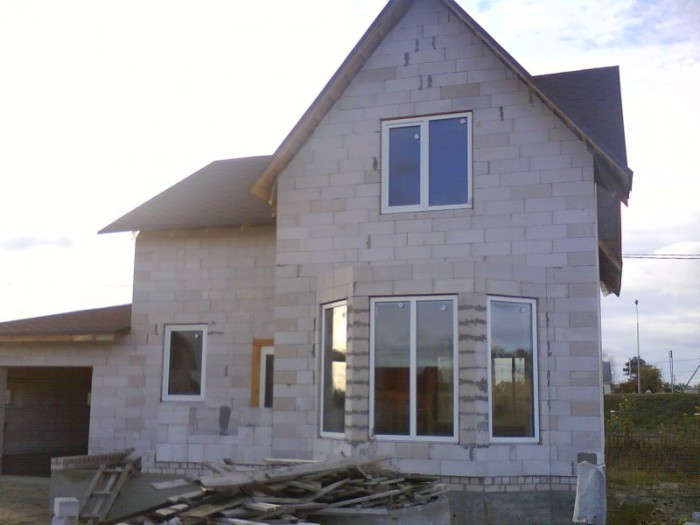 A house made of polystyrene concrete also has some disadvantages associated with the disadvantages of this material.
A house made of polystyrene concrete also has some disadvantages associated with the disadvantages of this material.
A house made of polystyrene concrete, reviews of which are mostly positive, has some disadvantages associated with the disadvantages of this material:
- The product has low vapor permeability. Because of this, moisture can accumulate in the structure of the walls, which will cause a decrease in the thermal insulation characteristics of the enclosing structures.
- It is not fully understood how polystyrene behaves after long-term operation.
- Also, the toxicity of the material has not been fully investigated, because styrene can easily be released into the environment.
- During a fire, the material, although not subject to ignition, emits toxic gases. Moreover, after a strong fire, the walls of a house made of polystyrene concrete will have to be completely dismantled, since the strength of the material is significantly reduced.
What is polystyrene concrete
Polystyrene concrete wall blocks
When creating this material, the engineers were faced with the task of coming up with a building material for the walls, which, with a limited thickness, will not need additional insulation, and to make sure that the flammable foam becomes safe in this regard. As a result, we got what we have.
The composition of polystyrene concrete includes: Portland cement, granules of expanded polystyrene (aka polystyrene), quartz sand, plasticizing additives to reduce the delamination of the mixture and increase its elasticity, as well as water. Together, this gives the material the following positive and negative properties (let's start with the first ones):
Low Density Polystyrene Concrete Building Blocks
The material can be used in a very high temperature range. If we take into account the possible drops on the entire planet, then we can say that it has no restrictions at all.
Polystyrene concrete perfectly tolerates its sharp drops, which is important.
Humidity for polystyrene concrete is also not a problem. The presence of polymer granules in the structure greatly reduces the absorbency of the blocks, which is especially good for regions with high humidity.
Due to the fact that moisture practically does not penetrate into the material, its frost resistance also increases.
Manufacturers claim that the material is able to withstand from 150 to 300 defrosting cycles, which, as you know, is a lot. And, importantly, this does not in any way affect its thermal insulation characteristics.
Polystyrene concrete wall blocks - material structure
Thermal insulation and sound insulation characteristics of expanded polystyrene concrete are at a very high level
What can I say, the creators managed to achieve the desired effect.
Polystyrene concrete is lightweight, thanks to which a lightweight foundation can be laid under walls and ceilings, which is important for private low-rise construction, since it can significantly reduce material costs.
The material can be purchased in liquid form or prepared by yourself to be poured into the desired forms. Thus, you can make overlappings and lintels over door and window openings - we will talk about this a little later.
If desired, the building box can be made monolithic using the same liquid mixture - this construction technology is also gaining popularity today.
Construction from such blocks is much faster than from bricks, since they have large dimensions.
We also remind you that the material is light, which means that you can do without large lifting equipment.
The material is easily cut with a conventional hacksaw, which allows you to fit parts quickly and accurately.
Construction from polystyrene concrete blocks - house from panels
The material has many advantages, but it is not without its disadvantages.
Among their total number, it is worth highlighting the most important:
The polystyrene itself is moisture- and vapor-proof. It also endows the walls with ceilings made of it with the same property. For this reason, moisture gradually begins to accumulate inside buildings, since it simply has nowhere to go. High humidity means a decrease in thermal insulation characteristics, a violation of the microclimate, as well as the possibility of mold on the finish over time.
Filling the screed with liquid polystyrene concrete
Polystyrene concrete blocks are not as strong as expanded clay concrete and similar materials. However, in this regard, it is much better than gas blocks that have no filler at all. Weights can be hung on polystyrene concrete walls, but it is still recommended to use special fasteners.
Dowel for polystyrene concrete blocks
- Polystyrene concrete is a new material, and, despite all the assurances of manufacturers, we can judge about its durability only by some forecasting systems. That is, there are no real examples, and there cannot be.
- There are no precise toxicity studies, as styrene is harmful and can be released into the ambient air.
- The fire safety of polystyrene foam blocks has been established, but it is also known for certain that with strong heating, the polymers in the composition begin to emit toxic substances.At the same time, the strength of the material itself is greatly reduced, which means that if a fire occurs, but the building resists, it will still have to be dismantled.
Advantages and disadvantages
Polystyrene concrete is a material suitable for building prefabricated buildings. This type of aerated concrete has its pros and some cons.
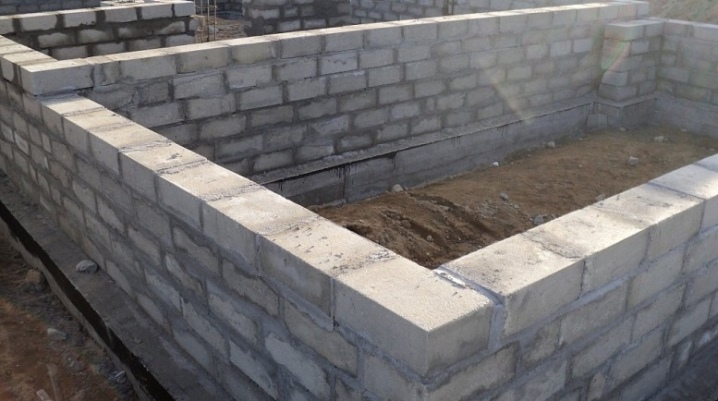
The advantages of polystyrene concrete include a number of characteristics.
- High degree of sound and heat insulation due to the porous structure of the material. Compared to aerated concrete, polystyrene concrete has a much lower thermal conductivity.
- The material is not affected by fungus, mold and decay. Rodents and insects show no interest in these blocks.
- High resistance to high humidity and sudden changes in temperature conditions.
- One block of expanded polystyrene concrete has a weight of only 22 kg. Thus, the material does not exert much pressure on the foundation.
- It has high strength and can be used for the manufacture of load-bearing partitions.
- It lends itself well to sawing, drilling, chasing.
- Belongs to the class of low-combustible building materials.
- The operational life of expanded polystyrene concrete is at least 100 years.
- It is odorless, does not emit components harmful to health into the environment, and is considered an environmentally friendly product.
- It can be used for the construction of pre-fabricated structures.
- It has a low cost, which differs in the downward direction by about 2.5 times compared to brick.
In addition to positive qualities, polystyrene concrete also has some disadvantages.
- Due to its low thermal conductivity and vapor permeability, a house built from polystyrene concrete will need a good ventilation system. This will help get rid of the high humidity in the rooms.
- Installation of large and heavy structures on a wall plane will require the purchase of special anchoring devices designed for aerated concrete. All other hardware in such walls will not hold.
- When buying a material that does not meet the standards of GOST, the quality and strength of expanded polystyrene concrete will be low.
- Under the influence of open ultraviolet rays, polystyrene granules completely burn out, leaving voids in the material instead of themselves, reducing strength and increasing thermal conductivity.
- The low density of the material makes the installation of window and door units problematic. If the installation rules applied to cellular concrete are violated, the fastenings of door and window structures will be loosened in a few years.
- Walls made of polystyrene concrete have low adhesion to plaster mortars.
House of polystyrene concrete blocks: construction features
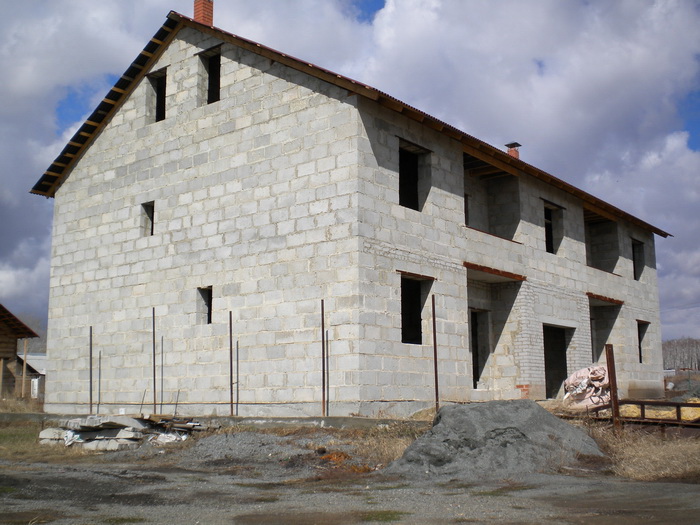 Before giving preference to polystyrene concrete, you need to know the parameters of the structure
Before giving preference to polystyrene concrete, you need to know the parameters of the structure
Before giving preference to polystyrene concrete, you need to know the parameters of the structure, which are limited by the following indicators:
- the use of roof rafters of an inclined type;
- the thickness of the outer wall panels cannot be less than 375 mm;
- the size of the height from the level of the lower rafters to the level of the upper opening cannot be less than 0.6 m;
- the recommended width of an ordinary wall is from 1.2 m;
- the height of the building is not more than 2 floors;
- width of openings up to 2 meters;
- altitude indicators of each floor no more than 3 meters;
- width of corner walls from 180 cm.
And if your house is supposed to fit into these parameters, you can choose polystyrene concrete as a building material.
Arrangement of the foundation
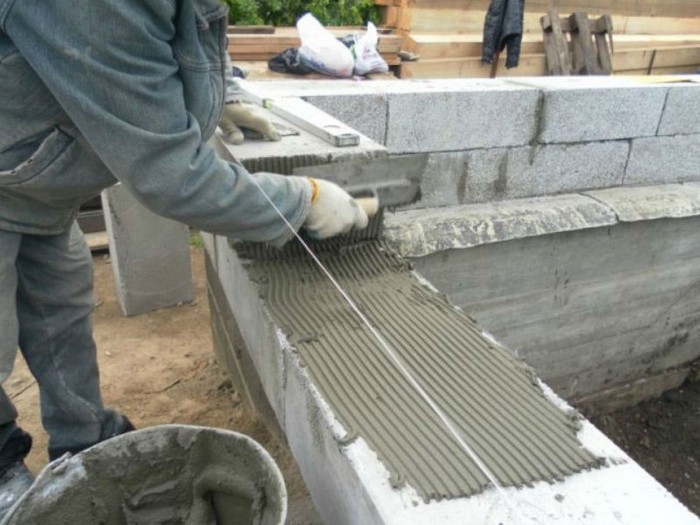 The supporting base for this material can be made lightweight
The supporting base for this material can be made lightweight
Here it is worth mentioning savings: the supporting base for this material can be made lightweight. The low density of the walls makes it possible to erect buildings on soft and difficult soils.The best choice would be a reinforced tape base, which has sufficient strength and maintains the stability of the shape of the blocks, and therefore the entire structure as a whole.
To lay a typical strip foundation for the construction of a house from expanded polystyrene blocks, it is necessary to dig a trench up to 0.5 m, tamp, waterproof it, equip the formwork and build a reinforced frame. Then all this is poured with a concrete composition in compliance with the dimensions: the above-ground part is at least 40-50 cm.
Erection of wall structures
After the completion of work with the foundation, the construction of the building begins. External masonry is made of structural blocks with good energy saving, the dimensions of the walls are 375 mm external and 295 mm internal. The evenness of the masonry, as usual, is checked by the level, but the blocks are laid end-to-end, without gaps. It is recommended to use an adhesive composition as a mixture, since cement mortars are not entirely suitable for this material.
The formation of ceilings over openings exceeding 300 cm in size takes place with the obligatory use of metal channels, but for convenience, blocks for laying above the channels can be cut.
Second floor
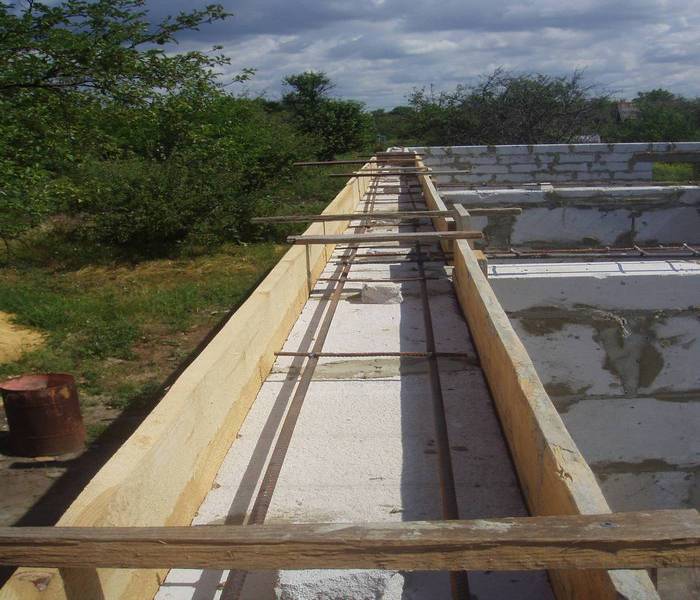 After the completion of the arrangement of the first floor, the formwork for the armopoyas is laid along the upper row and it is poured
After the completion of the arrangement of the first floor, the formwork for the armopoyas is laid along the upper row and it is poured
After the completion of the arrangement of the first floor, the formwork for the armopoyas is laid along the upper row and it is poured. Now you can build the second floor, but first, at the locations of the doors, on top of the armopoyas, you need to mount hollow slabs 22 cm wide.Reinforced concrete floors in the rest of the house are not needed, ordinary wooden floor beams with dimensions of 15 * 20 cm, laid in increments of up to 60 cm. The beams are then sewn up with a floor board.
Roof installation is carried out in accordance with a standard project. But to fix the Mauerlat, it is necessary to drill holes in the blocks in advance. By the way, the Mauerlat is replaced by a bar treated with antiseptic solutions. The rafter legs are attached with twists of wire and metal crutches driven into the masonry.
Final cladding work
 Facade work can be done with red hollow bricks
Facade work can be done with red hollow bricks
Here the owner will be faced with the fact that not every material easily falls on the surface of expanded polystyrene concrete. However, façade work can be done with red hollow bricks and fixed on a mixture of sand and cement applied directly to the masonry. Pay attention to the thickness of the seams, they should not be more than 10 mm.
The average time for building a house from start to finish is about 60-70 days. Plus communications and other engineering systems, as a result, after 4 months, the user receives a finished house suitable for comfortable living. Efficiency is really high, therefore, when choosing polystyrene concrete blocks, reading reviews, you should think about a material as an alternative to more expensive piece construction products. Additional advantages will be the affordable price component of construction and the versatility of the blocks: they can be cut, sawed and create the most bizarre forms of buildings that your imagination only wants to see.
How to make such a material yourself?
In an industrial setting, a variety of components are used in the manufacture in order to obtain a durable and lightweight material with various desired properties.
Making polystyrene concrete at home is a simpler process, but it is very difficult to achieve the quality of industrial products. Moreover, such work will take a long time. But if you do not have enough financial resources, but there are no problems with optimism, then it is worth trying.
This will require the following proportions of the components:
- Cement is one piece. Usually cement grade D400 or more is taken.
- Sifted sand - three parts.You can use ordinary river sand, which is carefully sieved before use.
- Polystyrene granules - six parts.
- Water - just enough water is needed so that the mixture does not spread.
- Plasticizers - any detergents can be used as them.
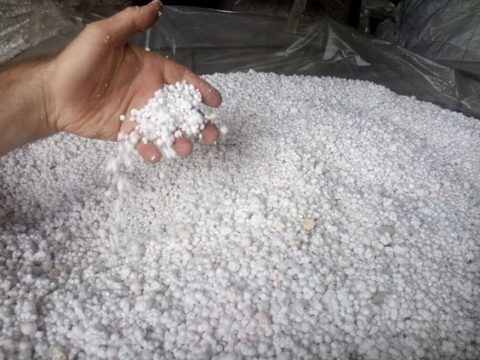 Polystyrene granules
Polystyrene granules
The production of polystyrene concrete at home consists of the following stages:
- Making molds for future blocks.
- Selection of all components in appropriate proportions.
- Mixing of components is done by hand or using a concrete mixer. The second option will greatly speed up the production time for a large batch of products.
- Once a homogeneous mixture is obtained, it can be poured into molds.
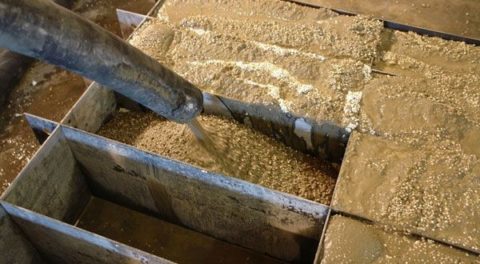 Form for making blocks
Form for making blocks
More information on this topic can be found in the video in this article: "How to make polystyrene concrete at home."
Summing up the above, we can conclude that polystyrene concrete is a very interesting building material. Its advantages can become a defining moment when choosing for the construction of a private house from expanded polystyrene concrete. Well, the shortcomings can always be eliminated, or they will not be so significant for you. Well, are we building a house with our own hands from polystyrene concrete?
Advantages of polystyrene concrete
Thanks to its unique composition and technology, expanded polystyrene has the following advantages:
- Resistant to low temperatures. The material is not afraid of the cold and feels great in the harsh Russian winters;
- Impressive parameters and low weight of the blocks. That allows you to significantly save on delivery and loading / unloading operations;
- Almost complete fire safety;
- No need to install cold bridges. Due to the high thermal insulation properties of the material;
- Budgetary cost and versatility;
- Durability of construction and minimal shrinkage. True, the durability is lower than that of a brick, and the degree of shrinkage depends on the selected weight of the blocks;
- Lack of difficulties in the implementation of communications;
- Environmental friendliness;
- Unpretentious care.
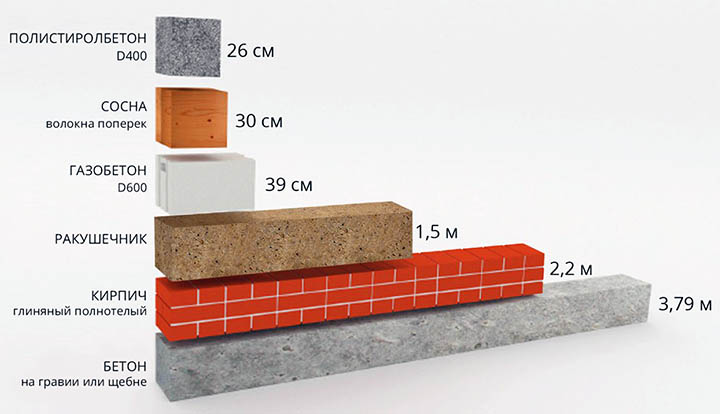
The transportation of expanded polystyrene and the installation process are also not difficult. This is due to the fact that the product is characterized by lightness and massiveness.
The service life of polystyrene concrete is not limited. Subject to the correct construction algorithm, the house will meet all the requirements.
Walls
For mounting walls made of polystyrene concrete you can use several ways:
- block masonry;
- a monolithic house made of polystyrene concrete can be made in removable and fixed formwork.
Block masonry
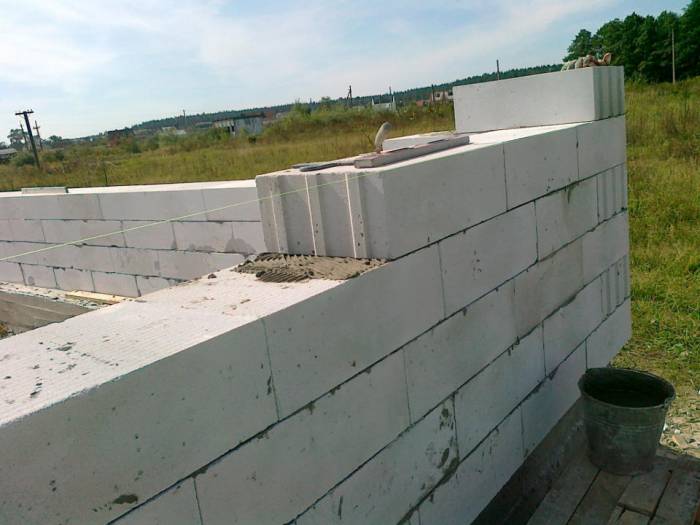 Laying begins from the highest corner of the base
Laying begins from the highest corner of the base
Usually, ready-made or self-cast polystyrene concrete blocks are used for the construction of a house. In this case, the installation of the walls of the house is carried out in the following order:
- Laying begins from the highest corner of the base. But first you need to perform horizontal waterproofing of the foundation. The concrete surface of the base must be insulated with two layers of roofing material on bitumen mastic.
- The first row is laid on a layer of mortar with a height of no more than 3 cm. The first block is set on a level.
- Next, the corner element is laid on the adjacent corner, to which the masonry will be carried out from the first block.
- Then, in the corners, the masonry is displayed several rows up. At the same time, blocks are left for bandaging the masonry.
- The fishing line is stretched between the erected corners. As each row is laid, the line rises to a higher level. The verticality of the walls is constantly controlled by the level or plumb line.
- It is also worth remembering that the thickness of the seam should not exceed 8 mm, so that cold bridges do not appear, which will worsen the thermal insulation qualities of the structure. Instead of a solution, it is better to use special glue. It gives better adhesion of the elements to each other than a conventional cement-sand mixture.
Removable formwork
 If you are going to build a house in a monolithic way, then you need to find a suitable formwork
If you are going to build a house in a monolithic way, then you need to find a suitable formwork
If you are going to build a house in a monolithic way, then you need to find a suitable formwork. For these purposes, plywood with a thickness of 1.5 cm is suitable. To protect against moisture, plywood can be wrapped with plastic wrap. You will also need a wall-width clamp with formwork. To facilitate the work, you need to make a comb - this is a section of a profile pipe 50 mm longer than the wall thickness with 10 cm long reinforcement bars welded to it.Further work is carried out as follows:
- First, the starting profile is mounted on one of the corners of the house. It is selected based on the thickness of the plywood. This profile is attached with self-tapping screws and dowels to the concrete base.
- Then two sheets of plywood are inserted into the profile so that a right angle is formed. Plywood is connected with metal corners.
- After the installation of the outer corners is completed, the inner corners are made of plywood in the same way. In this case, a pre-made comb will help you to facilitate the work. This tool slides between the plywood and holds one sheet while the other is attached. Internal corners are also fixed with steel corners.
- We close the ends with profile strips. The plank should have a protrusion like a thorn, which, after the mortar hardens, will give a notch necessary for a snug fit of the next layer without cold bridges.
- To firmly press the end strip, we use a clamp.
- We prepare the mixture in the same proportion as for pouring polystyrene concrete blocks.
- After pouring the mortar into the formwork, it is carefully compacted.
- Next, the formwork for the next layer is mounted. Moreover, it can be poured without waiting for the complete solidification of the previous layer. When pouring the next layer, the shields from the previous one are not removed.
- The formwork can be removed after 5-7 days.
Fixed formwork
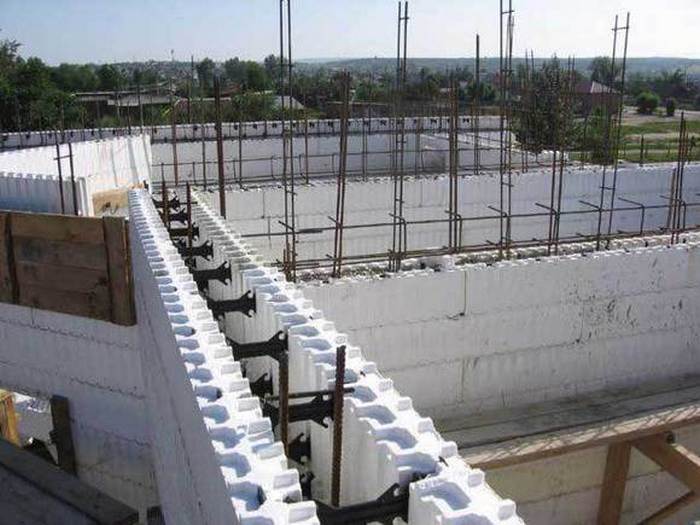 Installation with permanent formwork allows you to immediately finish the walls of the house
Installation with permanent formwork allows you to immediately finish the walls of the house
Installation with fixed formwork allows you to immediately finish the walls of the house. The essence of the method is that the space between two brick walls is filled with polystyrene concrete mortar. We work like this:
- We begin to install the walls from the highest corner of the base.
- First, we carry out the brickwork of the outer and inner surfaces of the walls. In the process of installation, we make a dressing. At the same time, through a row, we turn the bonding brick inward so that it performs the functions of reinforcing the walls.
- Pouring is performed simultaneously with the masonry construction process.
The installation of windows and doors can be performed immediately after the installation of the roof of the house. The thing is that the structure is not subject to shrinkage at all, so there is no need to wait several months before starting finishing work.
Advantages and disadvantages
To begin with, it should be noted that polystyrene concrete blocks have been known to the construction world for a long time. However, the material only became widespread in the 1960s. This is due to the fact that initially the production of such a material as polystyrene concrete was rather complicated and expensive. However, with the development of technology, the situation has changed. Today, expanded polystyrene concrete blocks are in demand in the process of building low-rise suburban buildings. The material is used not only in Russia, but also in other countries of the world, for example, the United States of America, Germany, France and so on.
The raw materials for the production of polystyrene concrete blocks are as follows:
- Portland cement (which is essentially a type of cement);
- water;
- granular polystyrene;
- quartz sand;
- plasticizers.
There are several methods for the manufacture of polystyrene concrete blocks, namely:
- handicraft (or foundry) - this method is similar to the procedure for making non-autoclaved aerated concrete, since all the necessary elements are interconnected, poured into specially designed molds and contained there until hardening;
- vibrocompression (or vibroforming) - this method is used in industrial production, it is quite complex and lengthy.
Polystyrene concrete blocks are not ideal building materials. They are characterized by a set of individual characteristics (both positive and negative).Thus, before purchasing a material and using it in construction, it is necessary to evaluate all the advantages and disadvantages.
To begin with, consider the existing advantages of the material.
- Availability. Polystyrene concrete blocks have a budget price. Thanks to this, the material is available for purchase to almost every person (regardless of his economic and social status in society).
- Low thermal conductivity. Thanks to this property, in the process of building a house, there is no need to equip additional wall insulation with the help of other materials.
- Low density and low weight. Due to this property of the material, you have the opportunity to reduce the load on the foundation of the house. This also reduces the material and financial costs of transportation and masonry.
- Low water absorption. Due to this characteristic of polystyrene concrete blocks, water (and any other liquid) is not absorbed into the surface. In addition, this property is associated with such a characteristic as low thermal conductivity.
- High quality soundproofing. In this regard, polystyrene concrete blocks can be used for the construction of buildings of any purpose.
- Simple handling. You do not need to have a lot of specialized theoretical knowledge or practical skills to process the material. Polystyrene concrete blocks are easily fed by sawing or chasing.
- Resistant to low temperatures. Due to their frost resistance, polystyrene concrete blocks are used for construction in various regions of our country (including the northern ones).
- Ecological cleanliness. Since polystyrene concrete blocks are environmentally friendly, they can be used for a variety of purposes.
Despite the large number of advantages, it is necessary to remember about the existing disadvantages.
Low level of compressive strength. In connection with this property of the material, it should be remembered that polystyrene concrete blocks are a material that is not suitable for the construction of tall buildings. They can be used to build structures no higher than 2 floors.
Low vapor permeability
In this regard, it is important to create a special system for removing unwanted moisture, for example, an air conditioning or ventilation system.
Flammability. Polystyrene concrete blocks decompose when exposed to fire
A similar process is the reason for a decrease in the strength and heat-shielding characteristics of the material.
Fasteners. In order to attach something to a polystyrene concrete block, you need to use high-quality and reliable fasteners, for example, anchors and dowels.
Thus, you were able to make sure that the advantages of the material significantly outweigh its disadvantages.
No. 6. What to consider when choosing and buying polystyrene concrete?
Recently, a lot of low-quality products have appeared on the market, which is caused by the growing demand for polystyrene concrete. Some companies that previously produced foam blocks have now begun to produce polystyrene concrete, and often attempts to quickly please the market lead to a deterioration in product quality.
What should you pay attention to and what to check when buying?
- uniformity of filling with concrete granules;
- the same granules;
- correspondence of the block weight to the specified density;
- When ordering polystyrene concrete, you need to find out as much information about the manufacturer as possible, so you can and should safely ask where the production facilities are located, be interested in the manufacturing features. A normal manufacturer can invite you to production and demonstrate products, as well as tell you what wall thickness is better to make, what density of blocks to choose, advise how best to fix the shelves, which adhesives and solutions are best used for laying - in general, you should answer any question;
- quality certificate is another important point. But even its presence is not always a 100% quality guarantee.If you are dealing with a distributor and he shows you the quality certificate of the manufacturing company, then it does not hurt to make sure with the manufacturer that he cooperates with this seller.
